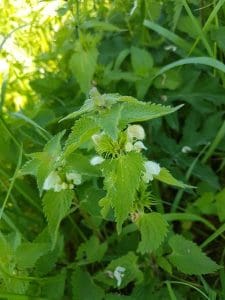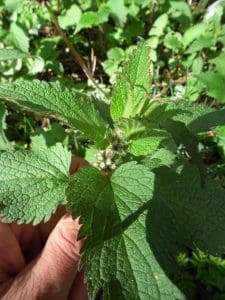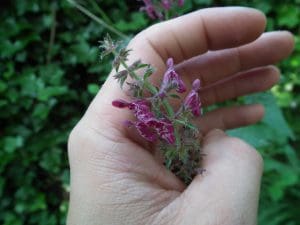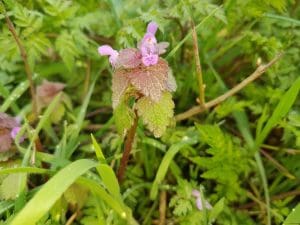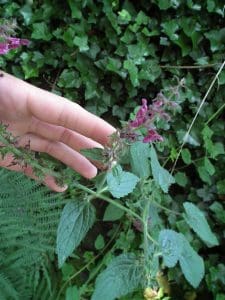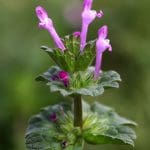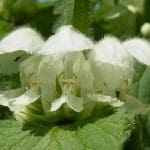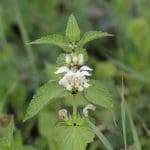Dead Nettles (white & red) / Spring / Summer / Autumn / Edible
Common Names
Dead nettle
Botanical Name
Lamium album & Other Species of Lamium
Scientific Classification
Kingdom – Plantae
Order –Lamiales
Family – Lamiaceae
Physical Characteristics for Dead Nettles
Lamium album & nearly all other Lamium Species are PERENNIAL growing to 0.6 m (2ft) by 1 m (3ft 3in) at a medium rate, with green, four-angled stems.
Dead Nettles are a group of plants sometimes confused with the common Stinging Nettle. They are actually in the Mint family although it has no mint flavour. They are edible and add an earthy flavour to salads and herb mixes.
Dead Nettle foraging video
https://youtu.be/YvGIYgQiE_g?si=g-VIzok6yXkJPllb
Leaves
The leaves are 3–8 cm (1.2–3.1 in) long and 2–5 cm (0.79–1.97 in) broad, triangular with a rounded base, softly hairy, and with a serrated margin and a petiole up to 5 cm (2.0 in) long; like many other members of the Lamiaceae, they appear superficially similar to those of the Stinging nettle (Urtica dioica) but do not sting, hence the common name “dead-nettle”.
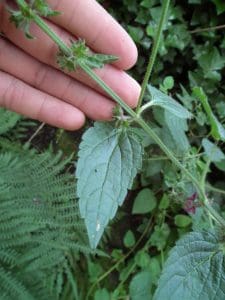
Flowers
The flowers are white, pink, red and sometimes yellow, depending on the species. They’re produced in whorls (‘verticillasters’) on the upper part of the stem, the individual flowers 1.5–2.5 cm (0.59–0.98 in) long. The flowers are visited by many types of insects, but mostly by bees.
Stems
The stems are hairy and square cross-sectioned
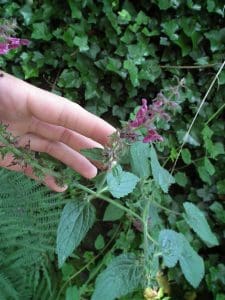
Habitat
Europe, including Britain, from Scandanavia south and east to Spain, the Himalayas, and Japan. Fields, hedgerows, woodland edges and clearings, and moist waste ground.
Known Hazards
None known
Could be Confused with
Other Dead nettles. Red Dead Nettle is often found alongside Henbit Dead-nettle – also edible – (Lamium amplexicaule), which is easily mistaken for it since they both have similar looking leaves and similar bright purple flowers; they can be distinguished by the stalked leaves of Red Dead-nettle on the flower stem, compared to the unstalked leaves of Henbit Dead-nettle.
Though superficially similar to species of Urtica (true nettles) in appearance, it is not related and does not sting, hence the name “dead-nettle”.
Edible Uses
Young leaves – raw or cooked. They can be added to salads or mixed with other leaves and cooked as a potherb. They can also be dried for later use. The leaves are a good source of vitamin A. A pleasant herb tea is made from the flowers
Notes on Herbal uses
White dead nettle is an astringent and demulcent herb that is chiefly used as a uterine tonic, to arrest inter-menstrual bleeding and to reduce excessive menstrual flow. It is a traditional treatment for abnormal vaginal discharge and is sometimes taken to relieve painful periods. The flowering tops are antispasmodic, astringent, cholagogue, depurative, diuretic, expectorant, haemostatic, hypnotic, pectoral, resolvent, sedative, styptic, tonic, vasoconstrictor and vulnerary. An infusion is used in the treatment of kidney and bladder complaints, diarrhoea, menstrual problems, bleeding after childbirth, vaginal discharges and prostatitis. Externally, the plant is made into compresses and applied to piles, varicose veins and vaginal discharges. A distilled water from the flowers and leaves makes an excellent and effective eye lotion to relieve ophthalmic conditions. The plant is harvested in the summer and can be dried for later use. A homeopathic remedy is made from the plant. It is used in the treatment of bladder and kidney disorders and amenorrhoea.
Extra notes from the Foragers
The flowers are visited by many types of insects, but mostly by long-tongued insects, like bees. Bumblebees are especially attracted to the flowers, which are a good source of early nectar and pollen, hence the plant is sometimes called the bee nettle.

Family
Lamiaceae
Video for Dead Nettle
Known hazards
None known.
Harvesting
Appears in early spring. It is in flower from Mar to October.
Potential lookalikes



